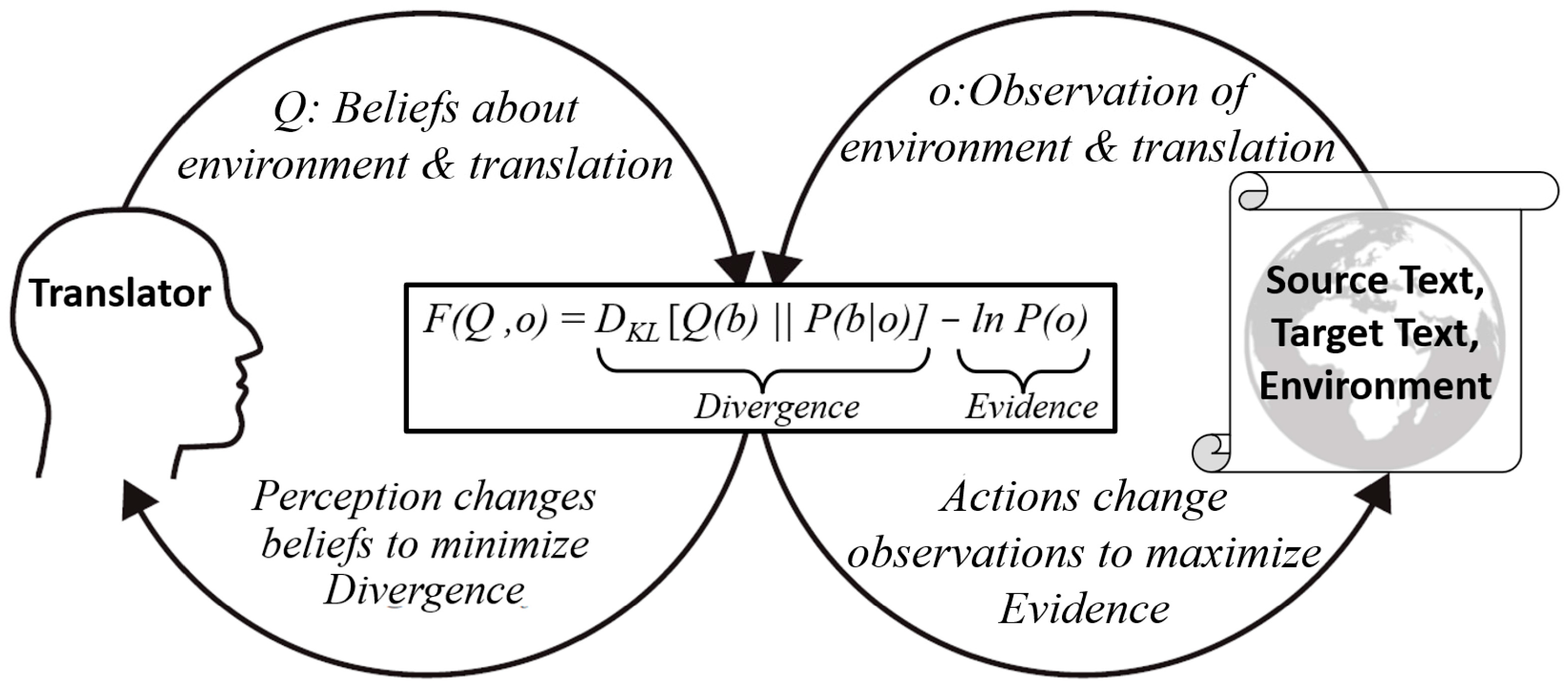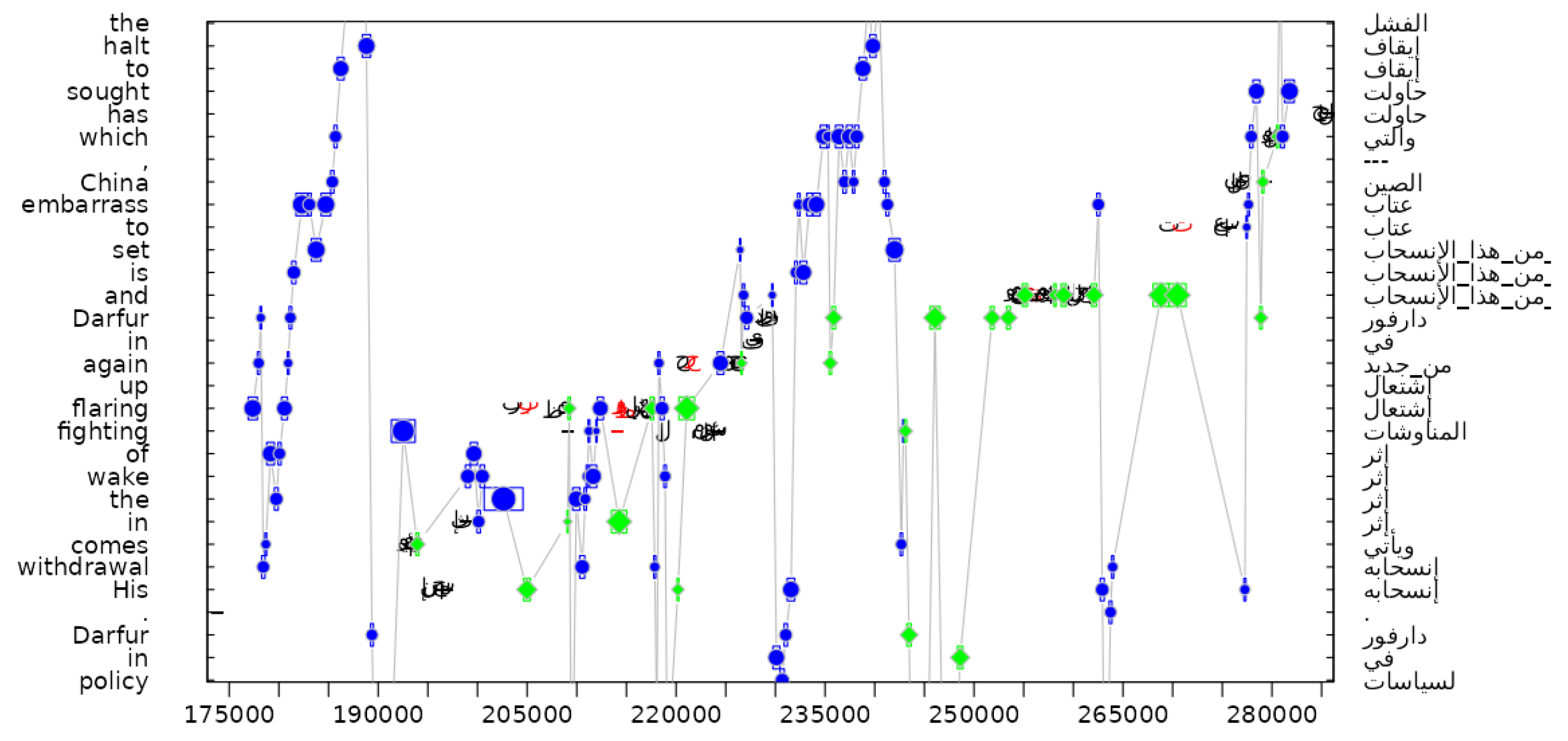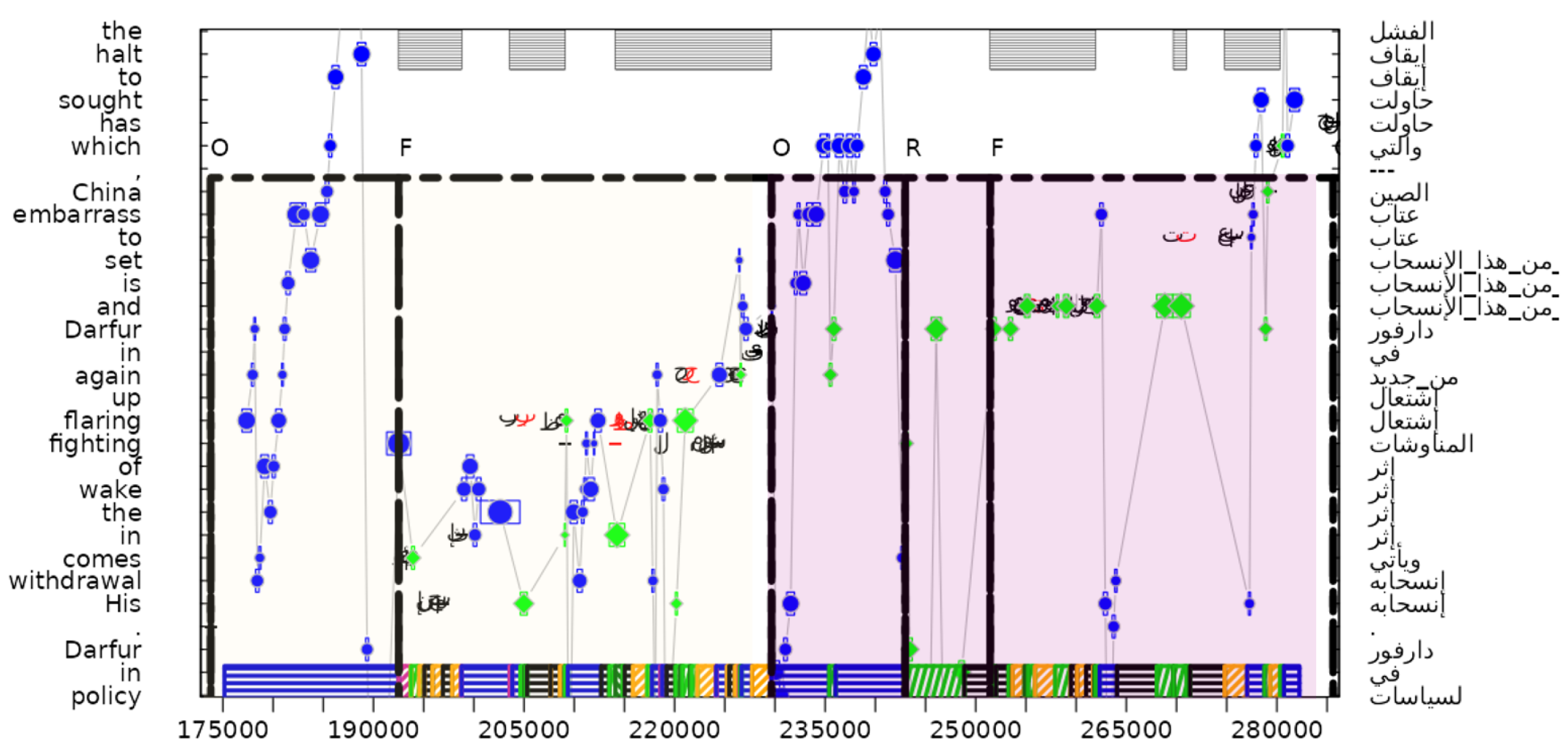Representationalism and Enactivism in Cognitive Translation Studies: A Predictive Processing Perspective
Abstract
1. Introduction
2. Representational View
2.1. Theory of Mind
2.2. S-Mode and I-Mode Translation
3. Enactivist View
S-Mode and I-Mode Revised
4. Predictive Processing
4.1. Active Inference (AIF)
4.2. Surprise and Prediction
4.3. Free Energy
- Inference-driven translation, where the translator tends to updates expectations based on new linguistic input. This view aligns with representational approaches, in which translation is seen as a decoding of meaning based on evolving mental representations.
- Action-oriented translation, in which the translator actively shapes the communicative situation—through strategic choices, recontextualization, or adaptive stylistic shifts—to render the translation environment more predictable and congruent with prior knowledge. This process-oriented view resonates with enactivist theories, emphasizing the translator’s role as an agent embedded in, and acting upon, a dynamic communicative environment.
4.4. Complexity and Accuracy
5. Hierarchical Organization of Translation States
5.1. Self-Evidencing
5.2. The Behavioral Translation Style Space (BTSS)
- (1)
- AUs (Activity Units) fragment the behavioral data into six categories that specify whether the translator is involved in ST or TT reading, whether s/he is typing, or simultaneously reading and writing. AUs unfold on the smallest temporal layer. They can be as short as a single fixation or a few keystrokes, up to the length of a linear reading pattern.
- (2)
- PUs (Production Units) consist of sequences of Keystroke Bursts and are interrupted by longer “willful” PU breaks (>3 *median between-word keystrokes, see [49]). While Keystroke Bursts are learned sensorimotor contingencies based on habits and embodied skills, PU breaks reflect moments of heightened cognitive–affective regulation, where the translator engages in deliberate sense-making, planning, or decision-making. They mark transitions from fluent embodied action to reflective control, revealing the temporal segmentation of the translation process into phases of automaticity and conscious modulation.
- (3)
- OHRF states are translation states that indicate the following:
- Orientation (O): prolonged ST reading, an epistemic affordance, enabling the translator to actively sample information from the ST, update internal belief states, or reduce uncertainty about meaning and intention.
- Hesitation (H): unexpected challenges, leading to longer typing pauses, rereading, or revisions, indicating cognitive uncertainty or conflict.
- Flow (F): fluent, uninterrupted production, a pragmatic affordance, characterized by minimal reading and short breaks, signifying full cognitive immersion.
- (4)
- TP (Translation Policies) are Perception–Action loops that consist of sequences of OHRF states. A TP starts out within an epistemic affordance (O), followed by one or more H, R, or F states. A TP typically ends in a pragmatic affordance (F), where well-aligned predictions and motor plans enable fluent production with minimal monitoring. A TP may also contain states of hesitation (H) that signal moments when predictive models are challenged and require revision, often triggering exploratory actions such as rereading or tentative reformulations, or revision (R), which involves deliberate restructuring of the target text, integrating new insights into the evolving translation. Through these cycles, TPs adaptively shape the translator’s interaction with the task environment, progressively minimising prediction errors and guiding the translation toward communicative adequacy.
5.3. An Example
6. Conclusions
Funding
Institutional Review Board Statement
Informed Consent Statement
Data Availability Statement
Conflicts of Interest
Abbreviation
| Symbol | Meaning | |
| Prior beliefs | P(b) | Initial beliefs/assumptions/expectations about translation environment, approach, style, terminology, etc. |
| True posterior | P(b|o) | The translator’s ideal beliefs after perfectly integrating all evidence. Usually, this is impossible to compute exactly and, therefore, approximated by Q(b). |
| Approximate posterior | Q(b) | The translator’s working model of updated beliefs after observing evidence. A tractable approximation of P(b|o) |
| Observation pattern | o(a,e) | Observation (reading pattern o) of previous action a and environment configurations e. Making explicit what is observed in translation |
| Observation probability | P(o(a,e)) | Probability distribution of observation patterns o(a,e) |
| Observation likelihood | P(o(a,e)|b) | Probability distribution of observation pattern o(a,e) given internal states (beliefs) b |
References
- Muñoz Martin, R. On paradigms and cognitive translatology. In Translation and Cognition; Shreve, G., Angelone, E., Eds.; John Benjamins: Amsterdam, The Netherlands, 2010; pp. 169–189. [Google Scholar]
- Risku, H.; Rogl, R. Translation and situated, embodied, distributed, embedded and extended cognition. In The Routledge Handbook of Translation and Cognition; Routledge: New York, NY, USA, 2020. [Google Scholar]
- Berger, J.; Brown, R. Rosenthal’s Representationalism. In Josh Weisberg, Qualitative Consciousness: Themes from the Philosophy of David Rosenthal; Cambridge University Press: New York, NY, USA, 2022; Available online: https://philarchive.org/archive/BERRR-6 (accessed on 26 August 2025).
- Fodor, J. The Language of Thought; Harvard University Press: Cambridge, MA, USA, 1975. [Google Scholar]
- Sperber, D.; Wilson, D. Relevance. Communication and Cognition; 2nd Edition Published in 1995; Basil Blackwell: Oxford, UK, 1986. [Google Scholar]
- Gutt, E.A. Translation and Relevance: Cognition and Context; Blackwell Publishing: Oxford, UK; St Jerome Publishing: Manchester, UK, 2000. [Google Scholar]
- Sperber, D. Intuitive and Reflective Beliefs. Mind Lang. 1997, 12, 67–83. [Google Scholar] [CrossRef]
- Origgi, G.; Sperber, D. Evolution, communication, and the proper function of language. In Evolution and the Human Mind: Language, Modularity and Social Cognition; Carruthers, P., Chamberlain, A., Eds.; Cambridge University Press: Cambridge, UK, 2000; pp. 140–169. [Google Scholar]
- Rosenthal, D.M. Consciousness and Mind; Clarendon Press: Oxford, UK, 2005. [Google Scholar]
- Carruthers, P. Phenomenal Consciousness; Routledge: London, UK, 2000. [Google Scholar]
- Carl, M. An Active Inference Agent for Modeling Human Translation Processes. Entropy 2024, 26, 616. [Google Scholar] [CrossRef] [PubMed]
- Varela, F.; Thompson, E.; Rosch, E. The Embodied Mind: Cognitive Science and Human Experience; MIT Press: Cambridge, MA, USA, 1992; ISBN 978-0262261234. [Google Scholar]
- Gibson, J.J. Affordances and behavior. In Reasons for Realism: Selected Essays of James J. Gibson, 1st ed.; Reed, E.S., Jones, R., Eds.; Lawrence Erlbaum: Hillsdale, NJ, USA, 1975; pp. 410–411. [Google Scholar]
- Hutto, D.; Myin, E. Radicalizing Enactivism: Basic Minds Without Conten; MIT Press: Cambridge, MA, USA, 2013. [Google Scholar]
- Hutto, D.; Myin, E. Evolving Enactivism: Basic Minds Meet Content; MIT Press: Cambridge, MA, USA, 2017. [Google Scholar]
- Chemero, A. Radical Embodied Cognitive Science; MIT Press: Cambridge, MA, USA, 2010. [Google Scholar]
- Kiverstein, J. The Meaning of Embodiment. Top. Cogn. Sci. 2012, 4, 740–758. [Google Scholar] [CrossRef] [PubMed]
- Hohwy, J. The self-evidencing brain. Nous 2016, 50, 259–285. [Google Scholar] [CrossRef]
- Seth, A. Being You: A New Science of Consciousness; Faber and Faber: London, UK, 2021. [Google Scholar]
- Friston, K. The free-energy principle: A rough guide to the brain? Trends Cogn. Sci. 2009, 13, 293–301. [Google Scholar] [CrossRef] [PubMed]
- Parr, T.; Giovanni, P.; Karl, J.F. Active Inference: The Free Energy Principle in Mind, Brain, and Behavior; The MIT Press: Cambridge, MA, USA, 2022. [Google Scholar] [CrossRef]
- Friston, K. Affordance and Active Inference. In Affordances in Everyday Life: A Multidisciplinary Collection of Essays; Springer: Berlin/Heidelberg, Germany, 2022; pp. 211–219. [Google Scholar]
- Nikolova, D. Predictive Processing Theory in Mind Studies: Cross Points with 4E Cognition and Cognitive Linguistics. Open J. Philos. 2025, 15, 349–366. [Google Scholar] [CrossRef]
- Sperber, D. Introduction. In Metarepresentations: A Multidisciplinary Perspective; Sperber, D., Ed.; Oxford University Press: Oxford, UK, 2000. [Google Scholar][Green Version]
- Woodruff, G.; Premack, D. Intentional communication in the chimpanzee: The development of deception. Cognition 1979, 7, 333–362. [Google Scholar] [CrossRef]
- Draperi, M.; Aïte, A.; Cassotti, M.; Le Stanc, L.; Houdé, O.; Borst, G. Development of cool and hot theory of mind and cool and hot inhibitory control abilities from 3.5 to 6.5 years of age. PLoS ONE 2022, 17, e0262251. [Google Scholar] [CrossRef] [PubMed]
- Murphy, T.F. Hot Cognition. Article, Emotional Regulation Emotions, Psychology. 2023. Available online: https://psychologyfanatic.com/hot-cognition/ (accessed on 26 August 2025).
- Gutt, E.-A. Challenges of metarepresentation to translation competence. In Translationskompetenz: Proceedings of LICTRA 2001: VII. Leipziger Internationale Konferenz zu Grundfragen der Translatologie; Fleischmann, E., Schmitt, P.A., Wotjak, G., Eds.; Stauffenburg: Tübingen, Germany, 2004; pp. 77–89. [Google Scholar]
- Gutt, E.A. On the significance of the cognitive core of translation. Translator 2005, 11, 25–49. [Google Scholar] [CrossRef]
- Hoza, J. Interpreting in the Zone, How the Conscious and Unconscious Function in Interpretation; Gallaudet University Press: Washington, DC, USA, 2016. [Google Scholar]
- Gallagher, S. Direct perception in the intersubjective context. Conscious. Cogn. 2008, 17, 535–543. [Google Scholar] [CrossRef] [PubMed]
- Clark, A. Surfing Uncertainty: Prediction, Action and The Embodied Mind; Oxford University Press: New York, NY, USA, 2015. [Google Scholar]
- Seth, A. Conscious Artificial Intelligence and Biological Naturalism. 2024. Available online: https://osf.io/tz6an_v1/ (accessed on 26 August 2025).
- Hohwy, J. A metaphysics for predictive processing. Synthese 2025, 206, 87. [Google Scholar] [CrossRef]
- Friston, K.J.; Lin, M.; Frith, C.D.; Pezzulo, G.; Hobson, J.A.; Ondobaka, S. Active Inference, Curiosity and Insight. Neural Comput. 2017, 29, 2633–2683. [Google Scholar] [CrossRef] [PubMed]
- Deane, G. Consciousness in active inference: Deep self-models, other minds, and the challenge of psychedelic-induced ego-dissolution. Neurosci. Conscious. 2021, 2021, niab024. [Google Scholar] [CrossRef] [PubMed]
- Ramstead, M.J.; Kirchhoff, M.D.; Friston, K.J. A tale of two densities: Active inference is enactive inference. Adapt. Behav. 2020, 28, 225–239. [Google Scholar] [CrossRef] [PubMed] [PubMed Central]
- Lundqvist, M.; Rose, J.; Brincat, S.L.; Warden, M.R.; Buschman, T.J.; Herman, P.; Miller, E.K. Reduced variability of bursting activity during working memory Scientific Reports. Sci. Rep. 2022, 12, 1–10. [Google Scholar] [CrossRef] [PubMed]
- Kaan, E.; Theres, G. Prediction in Second Language Processing and Learning. In Bilingual Processing and Acquisition; John Benjamins Publishing Company: Amsterdam, The Netherlands, 2021; Volume 12. [Google Scholar]
- Amos, R.; Pickering, M. Amos, R.; Pickering, M. A theory of prediction in simultaneous interpreting. In Bilingualism: Language and Cognition; Cambridge University Press: Cambridge, UK, 2019. [Google Scholar] [CrossRef]
- Halverson, S.L. ‘Default translation’: A construct for cognitive translation and interpreting studies. Transl. Cogn. Behav. 2019, 2, 187–210. [Google Scholar] [CrossRef]
- Fillmore, C. Frame semantics and the nature of language. Ann. New York Acad. Sci. 1976, 280, 20–32. [Google Scholar] [CrossRef]
- Clark, A. The Experience Machine: How Our Minds Predict and Shape Reality; Pantheon Books: New York, NY, USA, 2023. [Google Scholar]
- Hubscher-Davidson, S.E. Translation and Emotion: A Psychological Perspective; Routledge: New York, NY, USA, 2017. [Google Scholar]
- Sturm, A. Theory of Mind in Translation; Frank & Timme: Berlin, Germany, 2020. [Google Scholar]
- Robinson, D. Questions for Translation Studies; Benjamins Translation Library: Amsterdam, The Netherlands; Philadelphia, PA, USA, 2023; p. 162. [Google Scholar]
- Carl, M.; Mizowaki, T.; Ray, A.; Yamada, M.; Bandaru, D.S.; REN, X. Toward a Behavioural Translation Style Space: Simulating the Temporal Dynamics of Affect, Behaviour, and Cognition in Human Translation Production. arXiv 2025, arXiv:2507.12208. [Google Scholar]
- Carl, M.; Wei, Y.; Lu, S.; Zou, L.; Mizowaki, T.; Yamada, M. Hesitation, orientation, and flow: A taxonomy for deep temporal translation architectures. Ampersand 2024, 12, 100164. [Google Scholar] [CrossRef]
- Carl, M. Temporal Dynamics of Emotion and Cognition in Human Translation: Integrating the Task Segment Framework and the HOF Taxonomy. Digit. Stud. Lang. Lit. 2025, 2, 1–21. [Google Scholar] [CrossRef]



| Layer | Focus | |
|---|---|---|
| 1 | AU (Activity Units) | Minimal coordination of pausing, gazing, and typing. |
| 2 | PU (Production Units) | Chunks of planned typing activity; PUs consist of sequences of AUs, separated by production breaks. |
| 3 | OHRF (Orientation, Hesitation, Revision, Flow) | Affective aspects of epistemic/pragmatic affordances, OHRF states consist of sequences of PUs, and/or PU breaks. |
| 4 | TP (Translation Policies) | Perception Action loops are sequences of O(HRF)+ states. |
| OHRF | Time (s) | Description | |
|---|---|---|---|
| 1 | O | 175–193 | Read the entire ST sentence |
| 2 | F | 193–230 | Type the translation of an initial fragment of the sentence |
| 3 | O | 230–248 | Reread the last part of the sentence |
| 4 | R | 248–252 | Read/confirm the previously produced TT segment |
| 5 | F | 252–285 | Type the translation of a second fragment of the sentence |
Disclaimer/Publisher’s Note: The statements, opinions and data contained in all publications are solely those of the individual author(s) and contributor(s) and not of MDPI and/or the editor(s). MDPI and/or the editor(s) disclaim responsibility for any injury to people or property resulting from any ideas, methods, instructions or products referred to in the content. |
© 2025 by the author. Licensee MDPI, Basel, Switzerland. This article is an open access article distributed under the terms and conditions of the Creative Commons Attribution (CC BY) license (https://creativecommons.org/licenses/by/4.0/).
Share and Cite
Carl, M. Representationalism and Enactivism in Cognitive Translation Studies: A Predictive Processing Perspective. Information 2025, 16, 751. https://doi.org/10.3390/info16090751
Carl M. Representationalism and Enactivism in Cognitive Translation Studies: A Predictive Processing Perspective. Information. 2025; 16(9):751. https://doi.org/10.3390/info16090751
Chicago/Turabian StyleCarl, Michael. 2025. "Representationalism and Enactivism in Cognitive Translation Studies: A Predictive Processing Perspective" Information 16, no. 9: 751. https://doi.org/10.3390/info16090751
APA StyleCarl, M. (2025). Representationalism and Enactivism in Cognitive Translation Studies: A Predictive Processing Perspective. Information, 16(9), 751. https://doi.org/10.3390/info16090751






